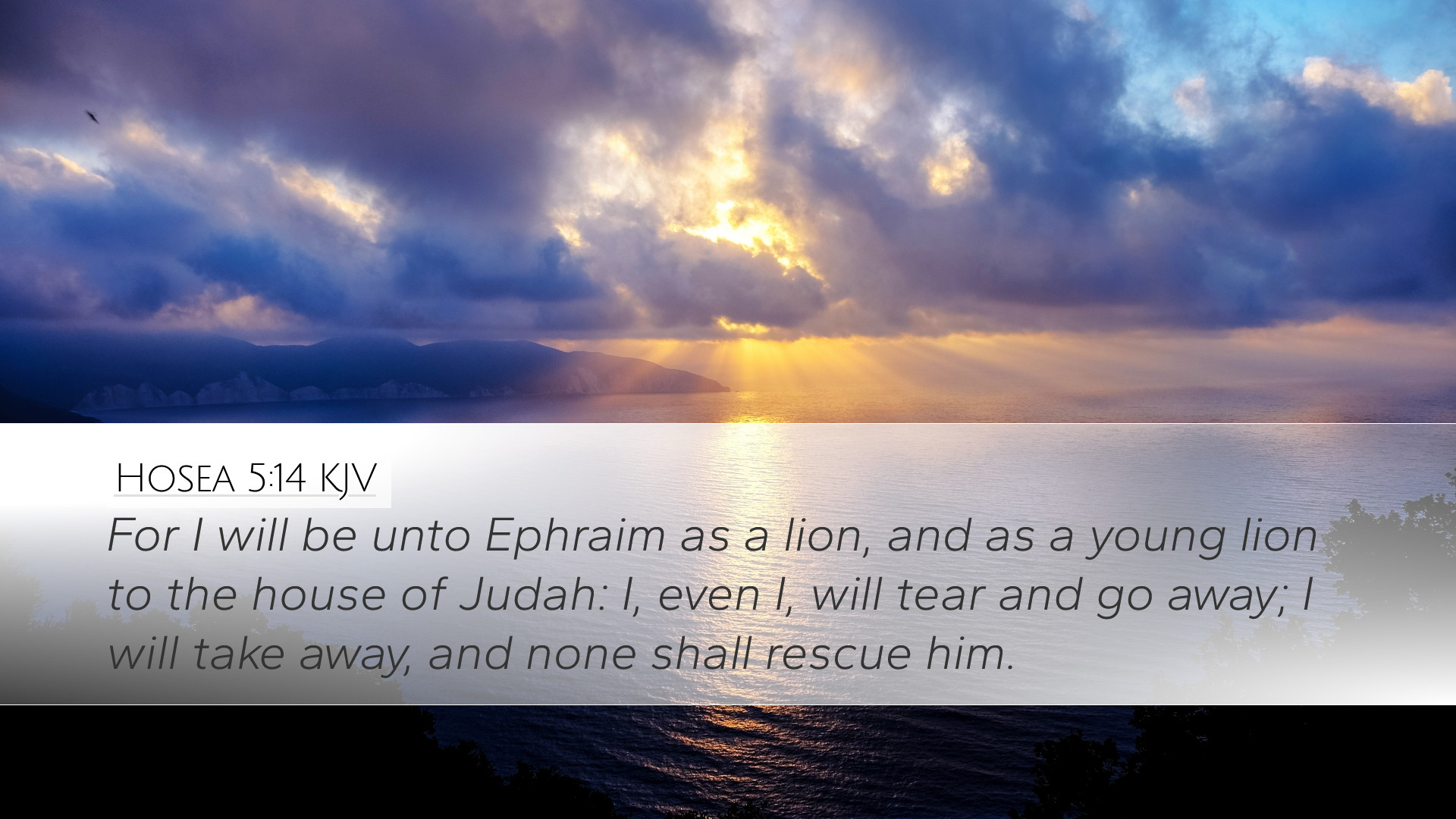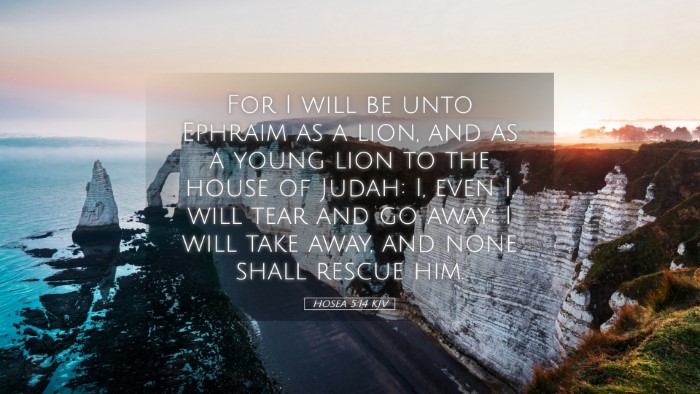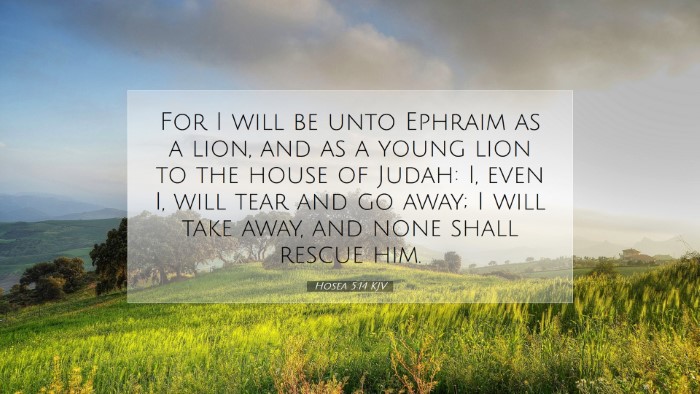Old Testament
Genesis Exodus Leviticus Numbers Deuteronomy Joshua Judges Ruth 1 Samuel 2 Samuel 1 Kings 2 Kings 1 Chronicles 2 Chronicles Ezra Nehemiah Esther Job Psalms Proverbs Ecclesiastes Song of Solomon Isaiah Jeremiah Lamentations Ezekiel Daniel Hosea Joel Amos Obadiah Jonah Micah Nahum Habakkuk Zephaniah Haggai Zechariah MalachiHosea 5:14
Hosea 5:14 KJV
For I will be unto Ephraim as a lion, and as a young lion to the house of Judah: I, even I, will tear and go away; I will take away, and none shall rescue him.
Hosea 5:14 Bible Commentary
Commentary on Hosea 5:14
In Hosea 5:14, the Lord declares through the prophet Hosea a striking image that encompasses themes of divine judgment and the restoration of His people. This verse reads:
"For I will be like a lion to Ephraim, and like a young lion to the house of Judah; I, even I, will tear, and go away; I will take away, and none shall rescue him."
Contextual Background
The prophetic ministry of Hosea takes place during a tumultuous era in Israel's history. The Northern Kingdom of Israel (often referred to as Ephraim) was deeply entrenched in idolatry, political corruption, and social injustice. Hosea's messages often reflect God's lament over a wayward people who have turned from Him.
Analysis of Key Elements in Hosea 5:14
Divine Imagery: The Lion
Hosea's use of the lion imagery is significant and multifaceted.
- Symbol of Power: The lion represents God’s majestic power and sovereignty. In ancient Near Eastern literature, lions are often symbols of kingship and divine authority. The implication here is that God is asserting His authority over His people in a manner that demands their attention.
- Symbol of Judgment: The roar of a lion instills fear, and this verse foreshadows impending judgment against the nation’s sins. Matthew Henry notes that the lion's tearing nature indicates the severity of God’s judgment because of Israel's unfaithfulness.
Ephraim and Judah: A Dual Judgment
The specificity of the reference to Ephraim and Judah indicates God’s judgment does not spare either kingdom. Ephraim symbolizes the Northern Kingdom, while Judah represents the Southern Kingdom.
- Collective Guilt: Albert Barnes emphasizes that both kingdoms are guilty of turning away from God. Hosea positions the judgment as an equal opportunity for both to feel the consequences of divine displeasure.
- Separation of Kingdoms: The mention of both kingdoms invites a reflection on their historical contexts. Adam Clarke notes the dynamics between the two and how their separation amplifies the tragedy of their collective downfall.
The Consequences of Rebellion
The line “I will tear, and go away; I will take away, and none shall rescue him” showcases the depth of impending calamity.
- Loss of Protection: The loss of God’s protection is a serious consequence of rebellion. When God withdraws, His people are susceptible to destruction and despair. Matthew Henry warns that without divine intervention, the Israelites would face dire circumstances.
- Desperation Without Salvation: The phrase “none shall rescue him” resonates with the finality of God’s judgment. It serves as a powerful reminder that when one has turned away from God, the avenues of salvation may become obscured. Clarke highlights that the situation reflects how the people, in their disobedience, have cut themselves off from God’s saving grace.
Theological Insights
This verse provides rich theological insights about God's character and human rebellion:
- God’s Righteous Judgment: The text emphasizes that God is not only loving but also just. He cannot tolerate sin indefinitely. The portrayal of Him as a lion signifies that His love also encompasses righteous judgment.
- Call to Repentance: Despite the grim warning, there remains an implicit invitation to repentance—a theme recurrent in the prophetic literature. Pastors and theologians often highlight the duality of judgment and mercy inherent in God’s nature.
Application for Today
In closing, Hosea 5:14 serves as a stark reminder of the consequences of sin and the reality of divine judgment. For pastors, students, and theologians alike, this verse brings several practical applications:
- Call to Holiness: There is a need for the church to pursue holiness and to be vigilant against the influences that lead to spiritual complacency.
- Encouragement for Repentance: Just as Hosea calls back the wayward people to repentance, present-day believers are encouraged to return to God wholeheartedly.
- Recognition of God’s Sovereignty: Understanding that God is always in control serves to provide comfort, even in times of judgment. There is assurance that God cannot be thwarted in executing His will.
Conclusion
Hosea 5:14 encapsulates a profound truth about God’s dealings with His people. The imagery of the lion signifies both divine authority and the harsh realities of divine retribution. In a contemporary context, this calls for reflective introspection among believers and leaders alike, encouraging a return to a right relationship with God.


